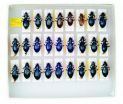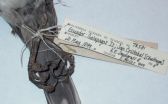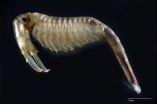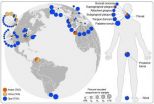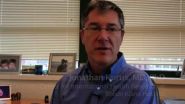(Press-News.org) Scientists from the California Academy of Sciences and more than 60 other international research institutions spanning six continents have responded to a recent paper in Science, which questioned current methods of scientific collecting and advocated the use of non-lethal alternatives. The response, led by Luiz Rocha, Ph.D., the Academy's Assistant Curator and Follett Chair of Ichthyology, and co-authored by such science luminaries as Harvard's E. O. Wilson and the Academy's Chief of Science and Sustainability, Margaret (Meg) Lowman, describes in detail the value that scientific collections provide across a wide range of disciplines, including conservation biology, and stresses the minimal impact that collecting has on populations. The response is published this week in Science.
In the original paper, "Avoiding (Re)extinction," the authors (Minteer et al.) argued that the collection of scientific specimens has played a significant role in species extinction, pointing to examples of now-extinct birds, frogs, and plants to support this idea. In response, Rocha et al. present significant evidence to the contrary. For example, of the 102 great auk (Pinguinus impennis) specimens in scientific collections, many are skeletons collected after extinction—and even when added together, the total number of specimens is a tiny fraction of the estimated millions of great auks harvested for food, oil, and feathers. Similarly, there are only nine scientific specimens of the now-extinct Mexican elf owl (Micrathene whitneyi graysoni), and these were collected when, according to field records, the species was still common—before the effects of habitat degradation and invasive species had pushed the owls to extinction.
"A few representatives taken for scientific collections is a drop in the bucket compared to the many other threats that species face today," says Rocha. "Habitat degradation and loss, unsustainable harvesting, and invasive species each play much larger and more devastating roles in population decline and species extinction."
In their paper, Minteer et al. went on to recommend alternatives to standardized collection methods used today, namely photography, audio recordings, and non-lethal tissue collection. Although in some cases these methods are useful in species identification, Rocha et al. argue that they fall far short of the wealth of information that scientific specimens provide. Species identification, they write, is not the only—and is often not the most important—reason to collect voucher specimens.
"Photographs and audio recordings can't tell you anything about such things as a species' diet, how and where it breeds, how quickly it grows, or its lifespan — information that's critical to assessing extinction risk, and vital IUCN Red List designation," Rocha explained. "And because photos and sound recordings provide only snapshots of individuals at one time and place, they can't be used to understand how a species and its ecology, distribution, and population dynamics have changed over time, or how individuals vary from one part of the species' range to another."
In their response, Rocha et al. point to several examples that illustrate the role scientific collections have played in understanding such things as the effects of climate change on populations and the spread of disease. In one such analysis, scientists looked at specimens from a wide range of taxa, collected over the past several decades or more, and found a significant correlation between an increase in mean ambient temperatures and a decrease in body size—a response that might affect the ability of some species to tolerate more dramatic swings in temperature extremes.
Scientists have also analyzed amphibian specimens collected over the past five decades or more, including many in the Academy's herpetology collections, to track the origin and spread of the deadly chytrid fungus in hopes of preventing its further spread. And this sort of disease tracking is not limited to chytrid.
"There are a lot of diseases in many different species that we can better understand by tracking them through time, addressing questions about where the disease came from, what the pattern has been, and whether anything has fundamentally shifted in the environment," says David Blackburn, Ph.D., Assistant Curator of Herpetology at the California Academy of Sciences. "But a snapshot from one time period won't allow us to answer those questions; we only get that ability from looking at many historical records over time."
In other cases, genetic data from decades-old scientific specimens has even been used to "de-extinct" species. One of these, the Vegas Valley leopard frog (Rana fisheri), was thought to have gone extinct in the wake of Las Vegas development. However, a study published in 2011 compared the genetics of specimens from the extinct population to individuals from surviving populations of similar-looking frogs elsewhere in the southwest and found them to be the same species.
These types of discoveries, the authors wrote, are "the hallmark of biological collections: They are often used in ways that the original collector never imagined." And with the continuing emergence of new technologies, this potential only grows.
That potential, combined with the increasing number of threats species face and the need to understand them, suggests that the need to collect scientific specimens—and to share the information they hold—has never been greater.
"We don't maintain collections for our own personal benefit," Blackburn emphasized. "We collect specimens and manage the collections we have as a resource for the community and the world. We are the stewards of this vital resource, and that means we should share them as widely and freely as possible."
"I am delighted, but not surprised, at the outpouring of support from scientists around the world who recognize the importance of collections for both research and conservation," says Meg Lowman, Ph.D., Chief of Science and Sustainability at the Academy. "The invaluable specimen collections held by institutions like the Academy provide one of our best tools for understanding and addressing the most pressing sustainability challenges of our time."
INFORMATION:
About Research at the California Academy of Sciences
The Institute for Biodiversity Science and Sustainability at the California Academy of Sciences is at the forefront of efforts to understand two of the most important topics of our time: the nature and future of life on Earth. Based in San Francisco, the institute is home to more than 60 research scientists and aquarium biologists, as well as 45.6 million scientific specimens from around the world—nearly 40,000 of which are alive and on display in the Academy's Steinhart Aquarium. The institute also leverages the expertise and efforts of more than 100 international Research and Field Associates and 300 distinguished Fellows. Through expeditions around the globe, captive breeding programs, and investigations in the lab, the institute's scientists strive to understand the evolution and interconnectedness of life. Through these same efforts, as well as through partnerships, community outreach, and public engagement initiatives, the institute aims to guide critical conservation decisions and address the challenge of sustainability.
Scientific collections play vital role in conservation biology
The value of scientific collections is vast, their impact on populations is minimal, and photographs and sound recordings are not enough
2014-05-22
ELSE PRESS RELEASES FROM THIS DATE:
A glimpse into nature's looking glass -- to find the genetic code is reassigned
2014-05-22
In the Lewis Carroll classic, Through the Looking Glass, Humpty Dumpty states, "When I use a word, it means just what I choose it to mean—neither more nor less." In turn, Alice (of Wonderland fame) says, "The question is, whether you can make words mean so many different things." All organisms on Earth use a genetic code, which is the language in which the building plans for proteins are specified in their DNA. It has long been assumed that there is only one such "canonical" code, so each word means the same thing to every organism. While a few examples of organisms ...
RI Hospital researcher and colleagues discover protein that may lead to malaria vaccine
2014-05-22
VIDEO:
Jonathan Kurtis, M.D., Ph.D., director of the Center for International Health Research at Rhode Island Hospital, talks about the latest findings in their research to find a vaccine for malaria,...
Click here for more information.
PROVIDENCE, R.I. – Rhode Island Hospital researchers have discovered a protein that is essential for malaria-causing parasites to escape from inside red blood cells. Antibodies to this protein trap the parasite inside these red blood cells. This ...
Growing inequalities make science more of a 'winner takes all' field
2014-05-22
ANN ARBOR—As new research documents growing inequalities in health and wealth, the gap between "haves" and "have-nots" is growing in the field of scientific research itself, says University of Michigan sociologist Yu Xie.
"It's surprising that more attention has not been paid to the large, changing inequalities in the world of scientific research, given the preoccupation with rising social and economic inequality in many countries," said Xie, research professor at the U-M Institute for Social Research and professor of sociology, statistics and public policy.
The forces ...
Fruit flies show mark of intelligence in thinking before they act
2014-05-22
Fruit flies 'think' before they act, a study by researchers from the University of Oxford's Centre for Neural Circuits and Behaviour suggests. The neuroscientists showed that fruit flies take longer to make more difficult decisions.
In experiments asking fruit flies to distinguish between ever closer concentrations of an odour, the researchers found that the flies don't act instinctively or impulsively. Instead they appear to accumulate information before committing to a choice.
Gathering information before making a decision has been considered a sign of higher intelligence, ...
Collecting biological specimens essential to science and conservation
2014-05-22
ANN ARBOR—Collecting plant and animal specimens is essential for scientific studies and conservation and does not, as some critics of the practice have suggested, play a significant role in species extinctions.
Those are the conclusions of more than 100 biologists and biodiversity researchers who signed a letter to the journal Science scheduled for online publication May 22.
The letter is a response to an April 18 Perspectives article in Science arguing that alternative methods of documentation—such as high-resolution photography, audio recordings and nonlethal tissue ...
Newborn health improves despite income gap
2014-05-22
The U.S. economic inequality gap has been widening for decades, and research shows that maternal disadvantage may have health consequences for newborns. A review of recent economic research, however, finds that the health of newborns has actually improved nationally in recent years, despite data that would suggest otherwise.
"That was really surprising to us," said Anna Aizer, associate professor of economics at Brown University. Aizer and Janet Currie of the National Bureau of Economic Research and Princeton University published the review in a special issue of Science ...
Ancient DNA ends Aussie claim to kiwi origins
2014-05-22
Australia can no longer lay claim to the origins of the iconic New Zealand kiwi following University of Adelaide research published in the journal Science today showing the kiwi's closest relative is not the emu as was previously thought.
Instead, the diminutive kiwi is most closely related to the extinct Madagascan elephant bird – a 2-3 metre tall, 275 kg giant. And surprisingly, the study concluded, both of these flightless birds once flew.
A new study by the University of Adelaide's Australian Centre for Ancient DNA (ACAD), has solved a 150-year-old evolutionary ...
Scientists identify potential vaccine candidate for pediatric malaria
2014-05-22
WHAT:
Researchers have identified a substance, or antigen, that generates antibodies that can hinder the ability of malaria parasites to multiply, which may protect against severe malaria infection. The antigen, known as PfSEA-1, was associated with reduced parasite levels among children and adults in malaria-endemic areas. Mice exposed to PfSEA-1 in an investigational vaccine also experienced lower malaria parasite levels. The discovery of PfSEA-1 could be a critical addition to the limited pool of antigens currently used in candidate malaria vaccines. The findings, which ...
Lower mantle chemistry breakthrough
2014-05-22
Washington, D.C.—Breaking research news from a team of scientists led by Carnegie's Ho-kwang "Dave" Mao reveals that the composition of the Earth's lower mantle may be significantly different than previously thought. These results are to be published by Science.
The lower mantle comprises 55 percent of the planet by volume and extends from 670 and 2900 kilometers in depth, as defined by the so-called transition zone (top) and the core-mantle boundary (below). Pressures in the lower mantle start at 237,000 times atmospheric pressure (24 gigapascals) and reach 1.3 million ...
Deep earth recycling of the oceanic floor
2014-05-22
Scientists from the Magma and Volcanoes Laboratory (CNRS/IRD/Université Blaise Pascal) and the European Synchrotron, the ESRF, have recreated the extreme conditions 600 to 2900 km below the Earth's surface to investigate the melting of basalt in the oceanic tectonic plates. They exposed microscopic pieces of rock to these extreme pressures and temperatures while simultaneously studying their structure with the ESRF's extremely powerful X-ray beam. The results show that basalt produced on the ocean floor has a melting temperature lower than the peridotite which forms the ...
LAST 30 PRESS RELEASES:
Numbers in our sights affect how we perceive space
SIMJ announces global collaborative book project in commemoration of its 75th anniversary
Air pollution exposure and birth weight
Obstructive sleep apnea risk and mental health conditions among older adults
How talking slows eye movements behind the wheel
The Ceramic Society of Japan’s Oxoate Ceramics Research Association launches new international book project
Heart-brain connection: international study reveals the role of the vagus nerve in keeping the heart young
Researchers identify Rb1 as a predictive biomarker for a new therapeutic strategy in some breast cancers
Survey reveals ethical gaps slowing AI adoption in pediatric surgery
Stimulant ADHD medications work differently than thought
AI overestimates how smart people are, according to HSE economists
HSE researchers create genome-wide map of quadruplexes
Scientists boost cell "powerhouses" to burn more calories
Automatic label checking: The missing step in making reliable medical AI
Low daily alcohol intake linked to 50% heightened mouth cancer risk in India
American Meteorological Society announces Rick Spinrad as 2026 President-Elect
Biomass-based carbon capture spotlighted in newly released global climate webinar recording
Illuminating invisible nano pollutants: advanced bioimaging tracks the full journey of emerging nanoscale contaminants in living systems
How does age affect recovery from spinal cord injury?
Novel AI tool offers prognosis for patients with head and neck cancer
Fathers’ microplastic exposure tied to their children’s metabolic problems
Research validates laboratory model for studying high-grade serous ovarian cancer
SIR 2026 delivers transformative breakthroughs in minimally invasive medicine to improve patient care
Stem Cell Reports most downloaded papers of 2025 highlight the breadth and impact of stem cell research
Oxford-led study estimates NHS spends around 3% of its primary and secondary care budget on the health impacts of heat and cold in England
A researcher’s long quest leads to a smart composite breakthrough
Urban wild bees act as “microbial sensors” of city health.
New study finds where you live affects recovery after a hip fracture
Forecasting the impact of fully automated vehicle adoption on US road traffic injuries
Alcohol-related hospitalizations from 2016 to 2022
[Press-News.org] Scientific collections play vital role in conservation biologyThe value of scientific collections is vast, their impact on populations is minimal, and photographs and sound recordings are not enough
